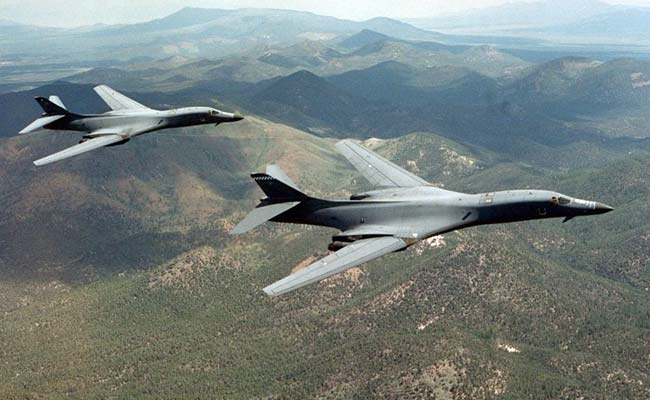
A US Air Force B-1B bomber flies over Osan Air Base in Pyeongtaek, South Korea. (Reuters Photo)
OSAN AIR BASE:
The United States on Tuesday sent nuclear-capable supersonic bombers streaking over ally South Korea in a show of force meant to cow North Korea after its recent nuclear test and also to settle rattled nerves in the South.
The B-1 bombers, escorted by US and South Korean jets, were seen by an Associated Press photographer as they flew over Osan Air Base, which is 120 kilometers (75 miles) from the border with North Korea. The bombers were likely to return to their base in Guam, without landing in South Korea.
Such flyovers are common during higher-than-normal animosity on the Korean Peninsula, which is technically in a state of war as there has never been a peace treaty to end the 1950-53 Korean War.
South Korea does not have nuclear weapons and relies on the US "nuclear umbrella" as a deterrent to North Korea. Washington also stations more than 28,000 troops in the South.
North Korea is keenly aware of the US presence on the peninsula and of what it considers the US nuclear threat. It uses such flyovers and the American military influence in the South in its propaganda as proof of US hostility that it claims as the reason it needs a nuclear bomb program.
 Last week's nuclear test, the North's fifth, was its most powerful test to date. Pyongyang's claim to have used "standardized" warheads in the detonation makes some outsiders worry that it is making headway in its push to develop small, sophisticated warheads that can be mounted on missiles that can reach the US mainland.
Last week's nuclear test, the North's fifth, was its most powerful test to date. Pyongyang's claim to have used "standardized" warheads in the detonation makes some outsiders worry that it is making headway in its push to develop small, sophisticated warheads that can be mounted on missiles that can reach the US mainland.
After the test, the North's nuclear weapons institute said it will take unspecified measures to further boost its nuclear capability, which analysts said hinted at a possible sixth nuclear test.
South Korea's Defense Ministry spokesman Moon Sang Gyun said Monday that South Korean and US intelligence authorities believe North Korea has the ability to detonate another atomic device at any time at one of its tunnels at its main Punggye-ri nuclear test site, where the five previous atomic explosions took place.
Moon refused to say what specific evidence pointed to another possible nuclear test. But the South's Yonhap news agency, citing unidentified Seoul government sources, reported Monday that there were signs the North had finished test preparations at one tunnel that has never been used. Yonhap did not elaborate.
Seoul, Washington and their allies have vowed to apply more pressure and sanctions after the test, the second this year.
(This story has not been edited by NDTV staff and is auto-generated from a syndicated feed.)
The B-1 bombers, escorted by US and South Korean jets, were seen by an Associated Press photographer as they flew over Osan Air Base, which is 120 kilometers (75 miles) from the border with North Korea. The bombers were likely to return to their base in Guam, without landing in South Korea.
Such flyovers are common during higher-than-normal animosity on the Korean Peninsula, which is technically in a state of war as there has never been a peace treaty to end the 1950-53 Korean War.
South Korea does not have nuclear weapons and relies on the US "nuclear umbrella" as a deterrent to North Korea. Washington also stations more than 28,000 troops in the South.
North Korea is keenly aware of the US presence on the peninsula and of what it considers the US nuclear threat. It uses such flyovers and the American military influence in the South in its propaganda as proof of US hostility that it claims as the reason it needs a nuclear bomb program.

A pair of B-1B Lancer bombers soar over Wyoming in an undated file photo
After the test, the North's nuclear weapons institute said it will take unspecified measures to further boost its nuclear capability, which analysts said hinted at a possible sixth nuclear test.
South Korea's Defense Ministry spokesman Moon Sang Gyun said Monday that South Korean and US intelligence authorities believe North Korea has the ability to detonate another atomic device at any time at one of its tunnels at its main Punggye-ri nuclear test site, where the five previous atomic explosions took place.
Moon refused to say what specific evidence pointed to another possible nuclear test. But the South's Yonhap news agency, citing unidentified Seoul government sources, reported Monday that there were signs the North had finished test preparations at one tunnel that has never been used. Yonhap did not elaborate.
Seoul, Washington and their allies have vowed to apply more pressure and sanctions after the test, the second this year.
(This story has not been edited by NDTV staff and is auto-generated from a syndicated feed.)
Track Latest News Live on NDTV.com and get news updates from India and around the world

